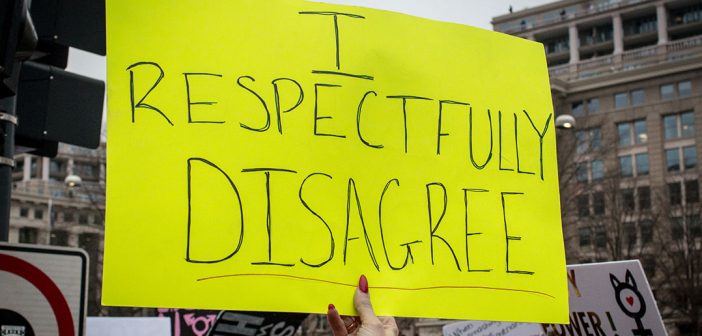The World Trade Organization meetings in 1999, the Iraq war in 2003, the Tea Party in 2009, Occupy Wall Street in 2011, Black Lives Matter in 2013—major protests in the United States took on a different feel at the turn of the century. And yet, 2017 feels as if something has changed yet again.
Why do some protests succeed and some fail? Why is the Tea Party movement getting a fresh new look? And what is a “Black Bloc?” We recently sat down with Heather Gautney, Ph.D., associate professor of sociology, to learn more.
Listen here:
Full transcript below
Patrick Verel: This is Patrick Verel, and this morning I am speaking with Heather D. Gautney, associate professor of sociology at the Lincoln Center campus here. There’ve always been new protest movements in the United States, but they seemed to take on a new tone in 1999, when the World Trade Organization met in Seattle. Since then, we’ve experienced protests in 2003 against the Iraq war, in 2009 by the Tea Party Movement, in 2011 by Occupy Wall Street, and of course, in 2013 by Black Lives Matter. It feels like it’s changed again though, do you agree?
Heather Gautney: I think it feels different because the net feels a little bit wider, and the protest events that you named, those movements were predominantly of left or left-leaning or progressive, with the exception of course, of the Tea Party, which was really on the other side of the political spectrum and more conservative. This feels a little bit broader in terms of involving a more centrist leaning, and I think that that’s very much associated with the Hillary Clinton loss in the election. On the negative side, I think it feels different because all of those protest actions that you named had real goals. The protests that we’re seeing now seem a lot less focused. The Women’s March, it’s very difficult to pinpoint exactly what the focal point of that was, aside from women’s rights.
Ashley Judd is the person who comes to mind and she starts listing all of these famous women, and how inspirational they are. She might name Gloria Steinem, but then she also named Condoleezza Rice. That really stuck out to me because I thought that’s an incredibly politically amorphous list of women. Some of that I think has to do about trying to show unity against Trump. Some of it I think also has to do with problems of organization and a desire to feel like people are doing something, but not necessarily having the tools to map out ahead of time or think strategically about what the street protest could actually achieve. It’s I think very helpful for people to show their dissent publicly and to engage in large numbers, so I think the protests are important for that reason, but it’s also very important for people to be thinking beyond the protest.
Patrick Verel: When you think about all those other movements that we talked about leading up to this, how successful do you think they all were?
Heather Gautney: It’s a mixed bag. The Seattle demonstration successfully shut down the meeting of the WTO and that’s what they wanted to do. That’s what all of the subsequent protests outside of the country around the World Bank and IMF during that period, wanted to pose the critique of free trade, and wanted to shut down the meetings. Matty and I would say that it was successful. In terms of actually thwarting free trade agreements, some of the protests in Mexico and of course in Canada, against the free trade of the Americas agreement, I think they’re very successful because they did actually … one could say that they played a hand in helping prevent those agreements from coming together.
The Iraq war protests were clearly unsuccessful. President Bush basically said, “I know what’s good for Americans and these people out there protesting in the street don’t understand the security issues that our country is facing.” The Black Lives Matter protests are difficult because that group is so decentralized and there’ve been so many individuals who’ve claimed association with Black Lives Matter. Think this happened with Occupy Wall Street, I think it also happened with Black Lives Matter that these are leaderless movements, but because of that, there are people who are making claims as spokespersons or leaders or associates of the movements who in some ways, their backgrounds or their personal material interests conflict with what the movement is about.
I think Black Lives Matter has been very successful in raising issues of racial discrimination. Certainly on college campuses, there’s been a big response to the movement. The Tea Party was clearly very successful in infiltrating the Republican party and actually having representatives elected in Congress, and I actually think that that’s what some of the new movement activity is … the protest might be amorphous or have a lack of direction, but I do see a lot of on-the-ground activity using the mechanism of the Democratic party to try to get progressive local elected officials put in local government, but also trying to shift the balance in Congress.
Occupy Wall Street I think, has been given a lot credit for raising awareness about economic inequality but I did not see it move the dial at all on the issues of major concern. Wall Street greed and the concentration of wealth in the 1%. That’s not a stain on the movement. It’s just that those were lofty goals for a movement, and I was very involved in Occupy Wall Street. I thought that the leaderlessness and the lack of demands was an asset, but in hindsight, I’ve changed my mind on that. I think the movement, it was big enough, and had enough women that it should have started making specific demands and doing what the Tea Party did, which was entering candidates.
Patrick Verel: I wonder if you can help me understand a certain kind of tactic that’s been adopted. They’re called the black blocks, which I understand are groups of anarchists who the aim is to disrupt events like the inauguration and destroy property as a way to draw attention. Can you tell me a little bit about the logic of these groups and how they work?
Heather Gautney: The black block, I believe that they originated in European context. In fact, I think it was Germany and they were definitely operative in Italy in the 90s, while all of the Seattle-like protests were going on. They tend to be small groups. Their idea is to be nimble. You might have a large protest that’s penned in and very organized and even sanctioned by the police. They are more about breaking the rules of protest and disrupting, whether that be disrupting street traffic, sometimes property destruction is part of it, but not always. But there’s an idea of having a flexibility and also being more confrontational with police. The jury’s still out on how productive those tactics are, some people are very critical of them because they tend to heighten the confrontation and then of course the police will come down on the larger protest harder, so it’s very difficult to have a planned protest with families and kids when there’s a threat of police confrontation.
But on the other side of the coin, sometimes that kind of confrontation can raise awareness of the brutality of the police. What the black block was trying to do by confronting police let’s say, at a protest of the World Trade Organization is to demonstrate that the police are more interested in defending property of Starbucks or defending trade than they are of defending the rights of individuals to protest.
Patrick Verel: Sounds like this is … when I hear the phrase walking a thin line, this is basically describes this, because you want to be confrontational ideally, because you want to get a message across. On the other hand, it’s possible to go too far and have the pendulum swing backwards.
Heather Gautney: This is the question for all of this stuff. Even the big Women’s March was all the famous actresses, well, are your tactics effective and are they gaining where you want to get them? Does it make sense to have call it a women’s strike, when most of the women aren’t going to be able to participate. It’s not really a strike then. It’s important what you call things in setting out goals, and messaging so that people have a sense of why they’re there, and what they’re doing. They will, I think things that need to be factored in when looking at tactics … property destruction on its own isn’t necessarily a bad thing. It’s whether or not the property destruction meets the goals of what the movement is trying to do and have an impact, and that just changes with every context.



